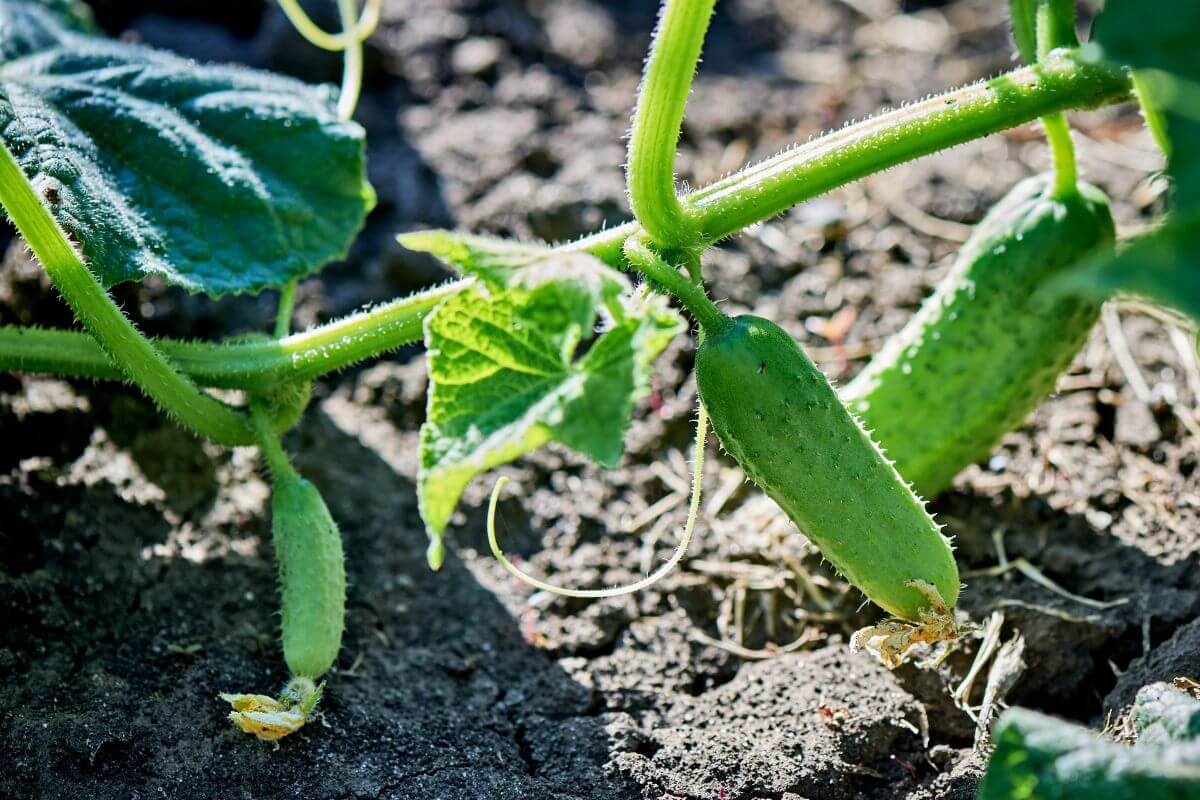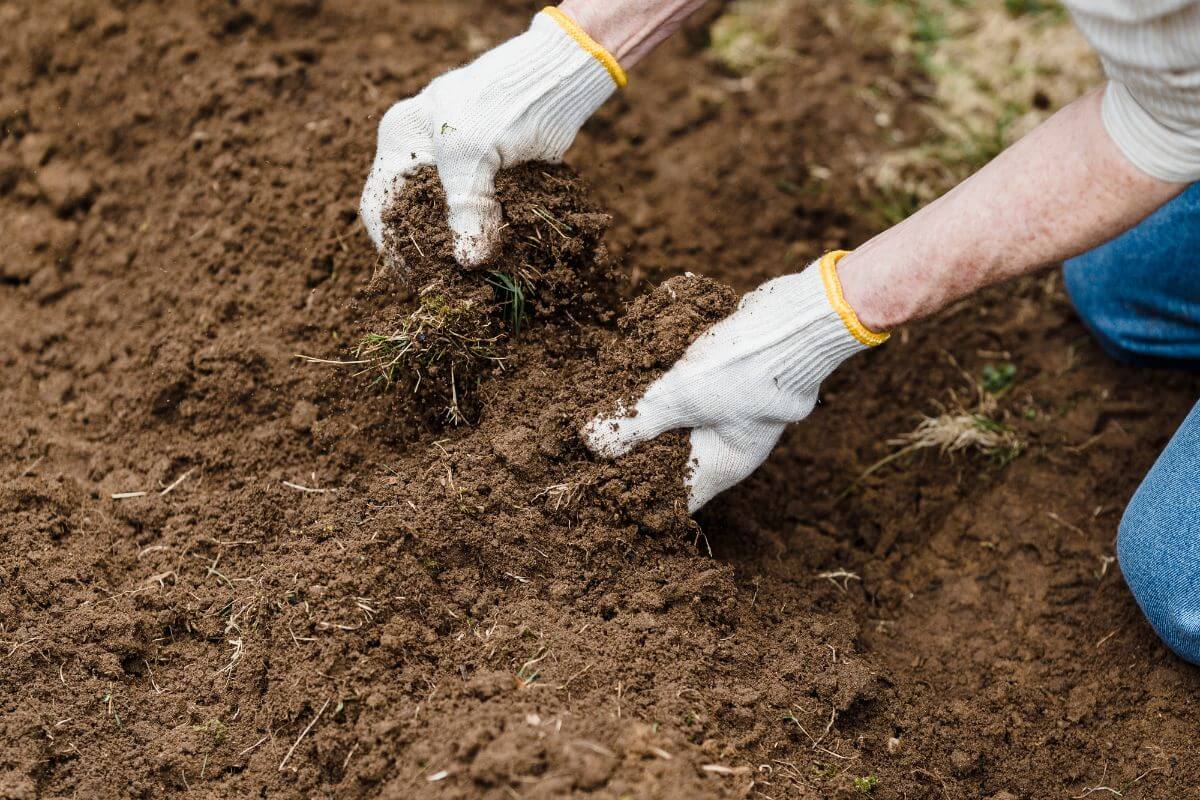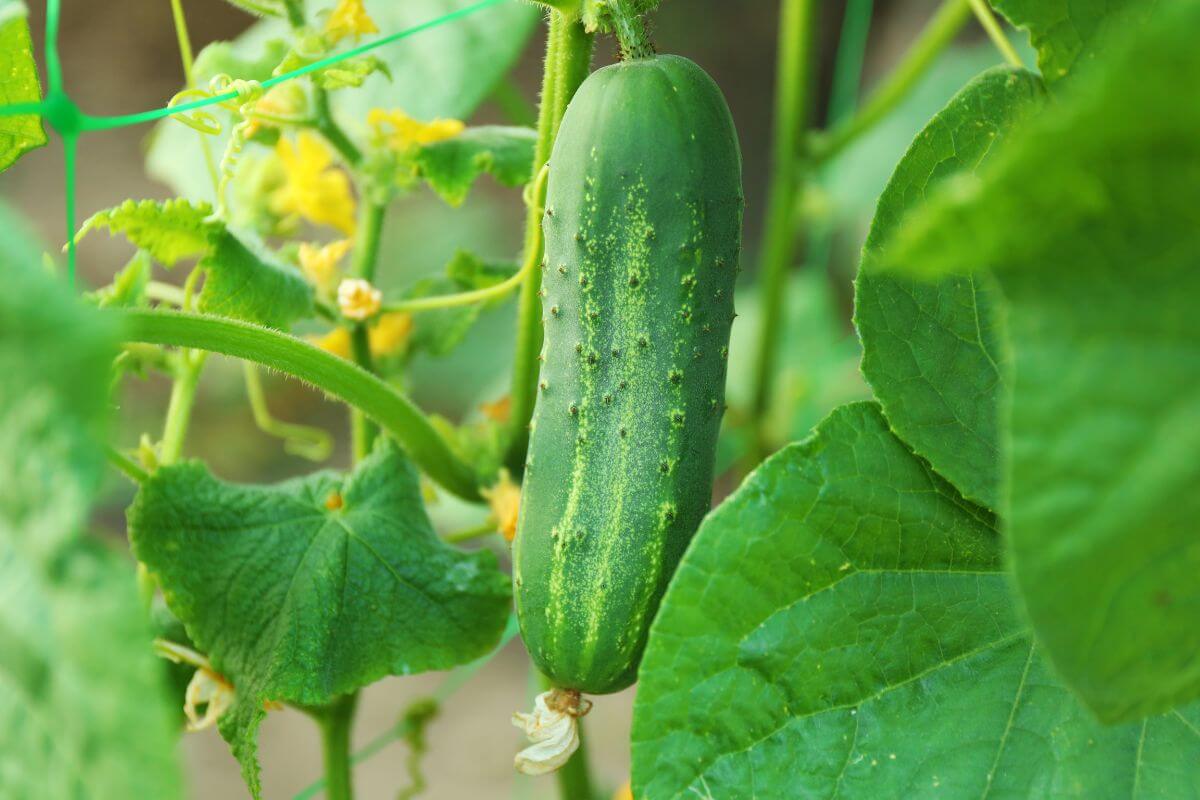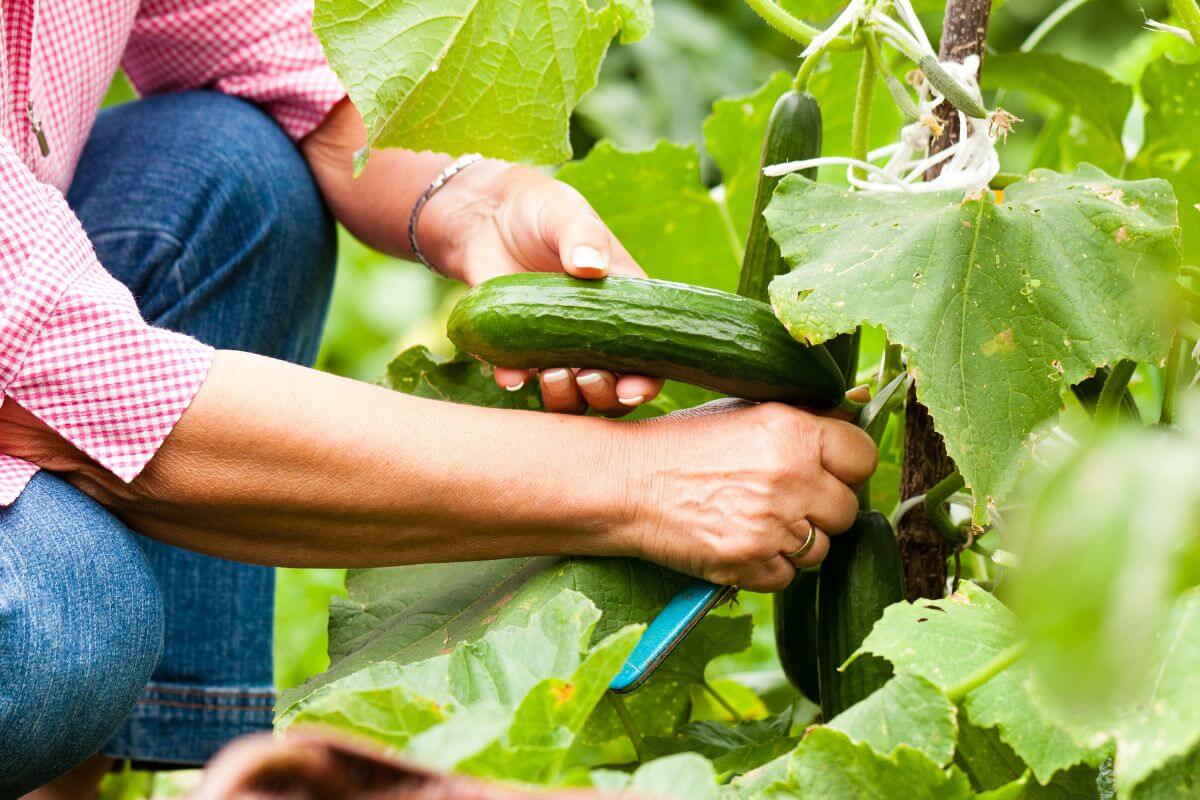Fresh cucumbers are so tasty and very good for you. They are packed full of vitamins and minerals, so why not have a go at growing these refreshing vegetables.
Cucumbers are an annual plant, which means they will produce fruits containing seeds, then die off at the end of the growing season. If you buy heritage or open pollinated varieties you will be able to save the seeds to plant again the next year.
This article will give you some detail about how to grow, plant, harvest, and store cucumbers, as well as prevent pests and disease.
- Related Article: Starting Organic Gardens
Organic Cucumber Varieties

Cucumbers come in all sorts of shapes and sizes, so you might find it hard to pick just one to grow. If you are growing for seed, I recommend that you do stick to one variety as cucumbers cross-pollinate easily.
To help you decide which to grow, first decide how you want to use them. Cucumbers are usually split into two groups; slicing or pickling.
Go for the slicing variety If you want to use your cucumbers fresh. If you want to store them, grow pickling cucumbers.
I’ve listed the top three open pollinated slicing and pickling varieties below, but there are many more available. There are also many organic hybrid varieties if you’re not planning on saving the seeds.
Top three open pollinated slicing cucumbers:
- Ashley Cucumber – Bred in Charleston in 1956, this variety produces dark green fruits about 6-8 inches long.
- Long Green Improved – Introduced in 1842, the cucumbers are around 10-12 inches long, straight, and have dark green skin.
- Marketer – Ideal for hot climates, the fruits are ready after 55 days, and are smooth, slender and 9-10 inches.
Top three open pollinated pickling cucumbers:
- Boston Pickling – This one can be used as both a pickling and slicing cucumber, so it’s perfect if you’re only growing one variety. Ready in 55 days, these bright green fruits grow between 3 and 6 inches long.
- Homemade Pickles – This vigorous bush produces crisp and sweet fruits that are 5 to 6 inches long.
- National Pickling – Bred in 1924 in Michigan, it is also good for pickling and slicing. Pick the baby fruits for pickled gherkins, and eat the larger ones fresh.
Site and Organic Soil Preparation

Cucumbers need full sunlight and soil that is not too dry or too wet.
Putting straw mulch around the cucumber plants will prevent soil from drying out, as well as keeping your cucumbers off the ground.
Dig in a lot of compost before planting and give each plant plenty of room.
You should fertilize with fish emulsion every 2 weeks until flowering starts. Then switch over to liquid kelp fertilizer once flowers start forming.
If you practice crop rotation, keep in mind that cucumbers are good to plant after cabbage crops.
Planting Organic Cucumbers
Cucumbers need warm soil, so wait until 2 or 3 weeks after the last frost. Ideally start them off in pots in a greenhouse or inside until they are big enough to plant outdoors.
If you’re using a trellis, give plants 6-10 inches in between. If you’re planning on letting them run along the ground, create 2 foot wide hills that are 6 feet apart and plant three plants per hill.
Growing Organic Cucumbers

Fertilize your cucumbers in the spring and with regular light feedings throughout the growing season. You can grow them in a warm sunny spot or in a greenhouse, and can plant them in grow-bags or directly into the garden soil.
Grow them with a trellis or sturdy netting if you’re short on space, otherwise you can leave them to trail over the ground.
Pinch out the growing tip once the plant has seven leaves, and do the same with flowerless side-shoots.
Keep the soil moist, but don’t water directly onto the plant.
Pests and Diseases
Whitefly and aphids are a common problem with cucumbers, and they encourage the growth of sooty mold. You can knock these pests off with a blast of water, or use a spray made with organic soap and water.
Coreopsis can be used as a companion plant to lure cucumber beetles away from your precious crop.
Powdery mildew is a white deposit on the leaves, and can be remedied by keeping the soil moist or, in extreme cases, moving the plant to somewhere cooler.
Harvest and Store Organic Cucumbers

Cucumbers ripen at varying rates and sizes depending on the variety, so make a note of what is says on your seed packet when you’re sowing your seed.
You can harvest cucumbers when they are ripe and leave the plant to produce more fruits. Regular harvesting will promote more fruiting. Cleanly cut the stem with a knife to harvest.
In general, cucumbers are ripe when they are uniformly green and firm, with slightly rounded tips. If they have turned yellow, they may be over ripe. But don’t despair if this happens, as you can use these over ripe fruits for saving seeds.
- Read More: How to Save Cucumber Seeds
Slicing cucumbers are best when fresh, and there is some debate as to where to keep them. While some say they last longer in the refrigerator, others maintain that they stay fresh at room temperature. Either way, they’re only going to last for a couple of weeks.
It’s best just to harvest your cucumbers as you need them and eat them straight away. If you have an abundance of cucumbers, you can freeze them, but the taste and texture won’t be the same.
If you have to freeze them, you can always use them for soup, or in place of ice cubes in drinks. To freeze, slice or dice your cucumbers. Then either put them on a cookie sheet until frozen and transfer them to freezer bags, or put them in ice trays.
Pickling is obviously the best way to store them, so the most practical thing to do is grow a variety that you can use for both slicing and pickling.
Here is how you pickle cucumbers. Let’s start with the ingredients you’ll need: salt, white wine vinegar, water, and pickling spices you want (like sugar or dill).
- Cut your cucumber into slices or leave whole if they’re small enough.
- Salt the cucumbers and wait until the salt dissolves.
- Heat up the water and vinegar in a pot and sterilize your jars in the dishwasher or oven.
- Add your pickling spices to the vinegar and water.
- Rinse off your cucumber with hot water and pack them into the still hot jars from the dishwasher.
- Pour in the hot vinegar and water. Fill the jars to the top and make sure there are no air bubbles.
- Carefully screw on the lids, use a cloth, and try not to scold yourself!
- Leave them to pickle for at least a couple of weeks.
How to Grow Organic Cucumbers Final Thoughts
Growing organic cucumbers isn’t difficult, it just takes time and patience.
Cucumbers are delicious and nutritious when fresh. They’re good for your skin and a great complement to a Gin and Tonic too!
Pickled cucumbers are amazing on burgers, with cheese, or just eat them straight from the jar.
For more how-to guides on growing organic herbs and vegetables, check these out:
Growing Organic Cucumbers FAQs
What is the best organic fertilizer for cucumbers?
The best organic fertilizer for cucumber is from organic matter. You should avoid using chemical fertilizers because they contain chemicals which could harm your plants. Instead, choose natural compost tea or manure based products like fish emulsion. These types of fertilizers provide nutrients needed by growing vegetables.
How do you fertilize cucumbers organically?
To organically fertilize cucumbers, you will first need to prepare the soil before planting your seedlings. This means adding lots of organic material such as leaves, grass clippings, peat moss, etc. The more organic materials you add, the better. It also helps to amend the soil with bone meal, kelp powder, worm castings, seaweed extract, and other similar substances. Once this has been done, plant your seedlings directly into their new home. Water well after planting.
How many cucumbers do you get from one plant?
One plant will produce about 10-15 medium-sized cucumbers per plant. That’s about 5-6 pounds of cucumbers. As a rule of thumb, plan to grow 2-3 plants per person you’re growing cucumbers for.
Do all varieties of cucumbers taste the same?
No, different cucumber varieties have different tastes. Some people prefer sweet tasting ones while others enjoy sour flavors. If you don’t know what kind of flavor you would like, then go ahead and buy some seeds. There are hundreds of different kinds available online. Just be careful to select those that suit your needs.
How high will cucumbers climb?
If grown properly, cucumbers can reach heights of over 6 feet tall. However, most gardeners find that they only grow around 3-4 feet tall. To encourage growth, keep an eye out for pests and diseases. Also, give your plants plenty of room to spread out so they won’t crowd each other.
Can I freeze my cucumbers?
Yes, you can store your cucumbers in the freezer for future consumption. Simply wash them thoroughly and pat dry. Keep in mind that freezing can damage the texture, so it won’t be the same as if it was fresh.
Is Epsom salt good for cucumbers?
Yes, Epsom salts help give a rejuvenation boost to cucumbers and helps to prevent blossom end rot. Adding Epsom salts to water used during watering encourages healthy root development. Epsom salts promote overall health and vigor in plants.
Is coffee grounds good for cucumber plants?
Coffee grounds are great at keeping weeds down around the cucumber plants. They also make excellent mulch for vegetable gardens. Coffee grounds work especially well when mixed with wood chips. Mulching keeps moisture levels up and prevents weed germination.
Why does my cucumber vine turn yellow?
Cucumber vines turn yellow when it’s over ripe, there isn’t enough sunlight reaching the vines, and or a lack of water. If it’s not time for the cucumbers to be over ripe yet, try to give the plants more light and water. Try moving your plants closer to windows or placing them under lights. Use grow lights or fluorescent bulbs, instead of incandescent bulbs. Be sure to water the plants and keep the soil moist too.
Is chicken manure good for cucumbers?
Chicken manure is very good for cucumbers and your compost. It’s rich in nitrogen which promotes strong roots and vigorous growth. If you want to grow your own chickens, they can help with pest control. Chickens eat lots of bugs, including aphids, which means less pest problems.

